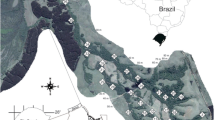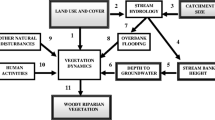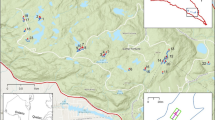Abstract
We quantified geomorphic and vegetational characteristics of 22 first-to-fourth order riverine forests located in the inner coastal plain of North Carolina. We used Detrended Correspondence Analysis to compare canopy composition among sites and relate measured environmental parameters to distribution of canopy trees and stream order. Both geomorphic and vegetational attributes could be used to functionally divide first-to-fourth order riverine systems into 17 headwater (first and second order streams) and 5 midreach systems (third and fourth order streams). As expected, stream order was found to be positively correlated (P<0.003) with drainage basin size, floodplain width, and channel width. The canopy of headwater reaches was dominated by various combinations ofLiquidambar styraciflua, Nyssa biflora, andAcer rubrum, while midreach systems were typically dominated byTaxodium distichum and/orNyssa aquatica. Canopy composition was similar to other low order stream floodplains in the southeastern USA from Alabama to Maryland. However, the canopy composition of bottomlands differed in that the generaFraxinus, Quercus, andUlmus were generally less important in the North Carolina bottomlands than elsewhere in the Southeast. Metrics obtained from these relatively unaltered ecosystems could be used to develop standards for assessing of wetland condition and provide appropriate criteria for designing restoration of altered low order riverine ecosystems.
Similar content being viewed by others
Literature Cited
Allen, B.P., Pauley, E.F. and R. Sharitz. 1997. Hurricane impact on liana populations in an old-growth southeastern bottomland forest. Journal of the Torrey Botanical Society 124:34–42.
Bernard, J.M. 1963. Lowland forests of the Cape May formation in southern New Jersey. The Bulletin of the New Jersey Academy of Science 8:1–12.
Bledsoe, B. 1993. Vegetation along hydrologic and edaphic gradients in a North Carolina coastal plain creek bottom. M.S. Thesis. North Carolina State University, Raleigh, NC, USA.
Brinson, M.M. 1993. Changes in functioning of wetlands along environmental gradients. Wetlands 13:65–74.
Brinson, M.M. and R.D. Rheinhardt. 1996 The role of reference wetlands in functional assessment and mitigation. Ecological Applications 6:69–76.
Brown, P.M. 1985. Geologic map of North Carolina. Department of Natural Resources and Community Development, Division of Land Resources, Raleigh, NC, USA.
Burns, R.M. and B.H. Honkala. 1990 Silvics of North America. Volume 1, Conifers. United States Department of Agriculture Forest Service, Washington, DC, USA. Agricultural Handbook 654.
Cole, C.A. R.P. Brooks, and D.H. Wardrop. 1997. Wetland hydrology as a function of hydrogeomorphic (HGM) subclass. Wetlands 17:456–467.
Cooper, J.R., J.W. Gilliam, R.B. Daniels, and W.P. Robarge. 1987. Riparian areas as filters for agricultural sediment. Soil Science Society of America Journal 51:416–420.
Gemborys, S.R. and E.J. Hodgkins. 1971. Forests of small stream bottoms in the coastal plain of southwestern Alabama. Ecology 52:70–84.
Glascock, S. and S.A. Ware 1979. Forests of small stream bottoms in the Peninsula of Virginia. Virginia Journal of Science 30:17–21.
Grosenbaugh, L.R. 1952. Plotless timber estimates—new, fast, easy. Journal of Forestry 50:32–37.
Hill, M.O. 1979 DECORANA: a FORTRAN, program for Detrended Correspondence Analysis and Reciprocal Averaging. Section of Ecology and Systematics, Cornell University, Ithaca, NY, USA.
Hill, M.O. and H.G. Gauch, Jr. 1980. Detrended Correspondence Analysis: an improved ordination technique. Vegetatio 42:47–58.
Holdridge, L.R. 1967. Life zone ecology. Tropical Science Center, San Jose, Costa Rica.
Kuchler, A.W. 1964. Potential natural vegetation of the conterminous United States. American Geographical Society, New York, NY, USA. Special Publication No. 36.
Lenat, D.R. 1983 Benthic macroinvertebrates of Cane Creek, North Carolina, and comparisons with other southeastern streams. Brimleyana 9:53–68.
Leopold, L.B., M.G. Wolman, and J.P. Miller. 1964. Fluvial Processes in Geomorphology. W.H. Freeman and Co., San Francisco, CA, USA.
Lindsey, A.A., J.D. Barton, and S.R. Miles. 1958. Field efficiencies of forest sampling methods. Ecology 39:428–444.
Lowrance, R.R., R.L. Todd, J. Fail, O. Hendrickson, R. Leonard, and L. Asmussen. 1984. Riparian forests as nutrient filters in agricultural watersheds. Bioscience 34:374–377.
McCune, B. and M.J. Mefford. 1995. PC-ORD. Multivariant Analysis of Ecological Data, Version 3.0 MjM Software Design, Gleneden Beach, OR, USA.
Monk, C.D. 1966. An ecological study of hardwood swamps in North-Central Florida. Ecology 47:649–654.
Parsons, S.E. and S. Ware. 1982. Edaphic factors and vegetation in Virginia Coastal Plain swamps. Bulletin of the Torrey Botanical Club 109:365–370.
Peterjohn, W.T. and D.L. Correll. 1984. Nutrient dynamics in an agricultural watershed: observations on the role of a riparian forest. Ecology 65:1466–1475.
Rheinhardt, R.D., M.M. Brinson, and P.M. Farley. 1997. Applying wetland reference data to functional assessment, mitigation, and restoration. Wetlands 17:195–215.
Sedell, J.R., G.H. Reeves, E.R. Hauer, J.A. Stanford, and C.P. Hawkins. 1990. Role of refugia in recovery from disturbances-Modern, fragmented, and disconnected river systems. Environmental Management 14:711–724.
Smock, L.A. and E. Gilinsky. 1992. Coastal plain blackwater streams. p. 271–311.In C.T. Hackney, S.M. Adams, and W.H. Martin (eds.) Biodiversity of the Southeastern United States: Aquatic Communities. John Wiley and Sons, Inc., New York, NY, USA.
Smock, L.A., E. Gilinsky, and D.L. Stoneburner. 1985. Macroinvertebrate production on a southeastern United States blackwater stream. Ecology 70:764–775.
Strahler, A.N., 1957. Quantitative analysis of watershed geomorphology. American Geophysical Union Transactions 38:913–920.
Sharitz, R.R. and W.J. Mitsch. 1993. Southern floodplain forests. p. 311–372.In W.H. Martin, S.G. Boyce, and A.C. Echternacht (eds.) Biodiversity of the Southeastern United States: Lowland Terrestrial Communities. John Wiley and Sons, Inc., New York, NY, USA.
United States Department of Agriculture. 1974. Soil survey of Pitt County, North Carolina. USDA, Natural Resource Conservation Service, Washington, DC, USA.
Wharton, C.H., M.M. Kitchens, E.C. Pendleton, and T.W Sipe 1982. The ecology of bottomland hardwood swamps of the Southeast: a community profile. U.S. Fish and Wildlife Service, Biological Services Program, Washington DC, USA. FWS/OBS-81/37.
Author information
Authors and Affiliations
Rights and permissions
About this article
Cite this article
Rheinhardt, R.D., Rheinhardt, M.C., Brinson, M.M. et al. Forested wetlands of low order streams in the inner coastal plain of North Carolina, USA. Wetlands 18, 365–378 (1998). https://doi.org/10.1007/BF03161531
Received:
Revised:
Accepted:
Issue Date:
DOI: https://doi.org/10.1007/BF03161531




